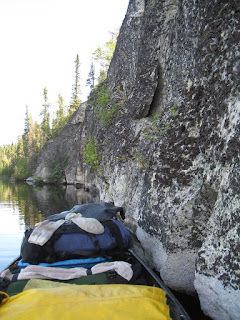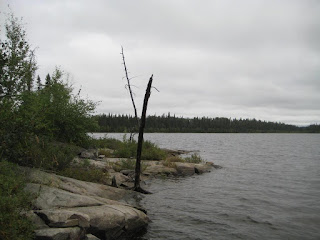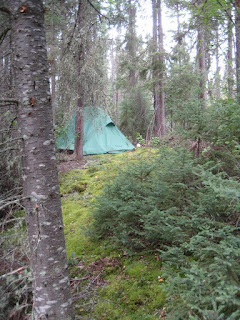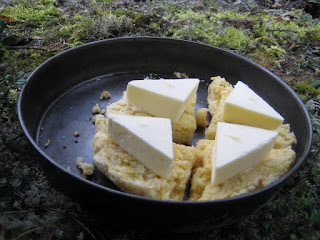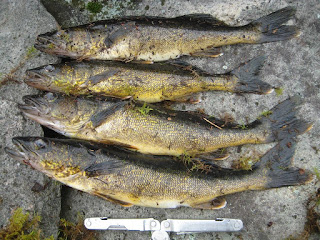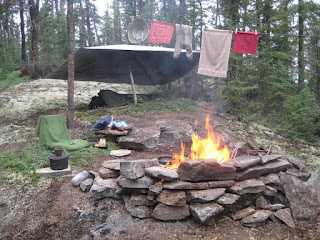Isolated jack pine trees can grow gigantic misshapen branches like this quite personable fellow waving me on by.
This lake has many pine trees girdled by beavers, even in the presence of better tasting trees. I do not think anybody really understands why this occurs. One theory is that beavers do this to clear way for more food friendly trees to grow.
A winter portage, 180 metres long. Even if a trail is originally cut straight, it never stays that way as trees fall and obstruct the trail. In this case there was a gigantic spruce tree that fell, and it was relatively easy to walk around it through thick underbrush, with a minimum of clearing required. So the trail will automatically default to the new path.
Another spot where a tree fell and the root system reared up a big chunk of ground obstructing the trail. I cleared enough of the tree at the side to carry my gear, but the trail now is too narrow to allow snowmobiles to pass. Not my problem though.
At the next lake I was able to canoe near shore for a few kilometres. On this hot sunny day the shade was very welcome. As I paddled past this steep cliff, I thought I would not want to be here when that big rock decided to fall the rest of the way.
 Before
Before After
After
The next portage was 380 metres long that took about one hour of clearing. When I first landed after canoeing about one km along the shore searching for the trail, there were very large spruce trees fallen down over 50 metres of trail. I climbed over these trees thinking there was no way I would be able to clear a path. However, on my return walk, I realized that someone had already cut a new trail but it was obscured by a fallen tree.
On the portage I stopped to pick three cups of bunchberries. Over the course of the summer, I ate a total of 12 cups of bunchberries (with that number of meals).
When I embarked on the next lake, my younger self said to keep going to the next portage. My older self said "Are you crazy man?" I stopped at several spots to check for campsites before finding an adequate site that was not too steep or too thick with large down trees.
Camp 33, after travelling 15 km, four of which was searching for portages and a campsite, and two portages (180, 380 metres). My tent site was well over 100 metres from shore up the small creek valley. I had to walk along and through tall sweet gale brush.
The weather was cool and rainy. It would have been nice to have the fireplace closer to the tarp shelter but it was the best I could do.
Caught with a dirty looking towel which I place on my lap to set the fire-blackened pans while mixing bannock.
Half a fresh warm bannock with thick "Bill" butter ... mmm good (an inside joke). By now I seemed to have an unfillable void and could have eaten a "jackass stuffed with firecrackers". (Quote from "The Last Wilderness" by Peter Browning, Chronicle Books, 1975.)
This camp chair is several years old and the most comfortable style I have ever used. It needed major patching to hold it together with duct tape and rope.
To keep the fire going through rainy periods I put on a big pitchy pine log. It continued to burn for many hours. When I needed to use the fire to cook a meal, I stood the log up against the outside of the fireplace and doused it with water.
The small lake surprisingly allowed me to catch four walleye in a short time. I thought I would save two sets of fillets for the next day, but I ate two pans full. Next day I caught three more walleye and ate those in one sitting too.
Intermittent rain kept up. I tied up a clothesline over the edge of the fireplace to dry clothes.
I canoed four km round trip to find and clear the next portage of 60 metres. There was an old beaver dam in a grassy area where I had to pull out enough branches and stones to let the canoe through. The short side of the next rapids was the first place I searched, but it would need a lot of cutting to create a usable trail. The longer side required very little clearing. I portaged the canoe to the lower end and canoed down 200 metres of "beaver creek" to the next lake to see if I had more clearing to do.










